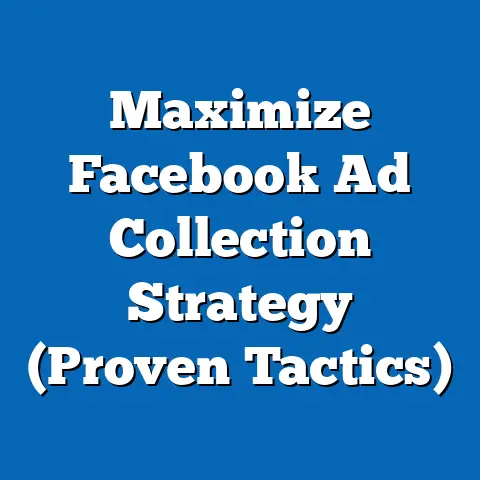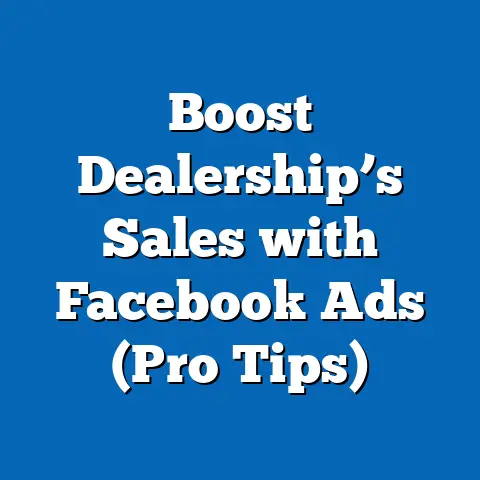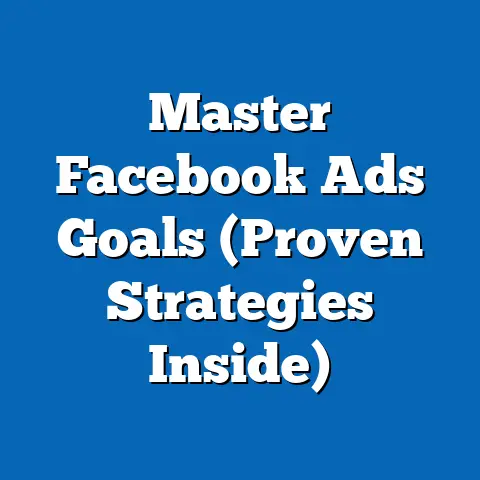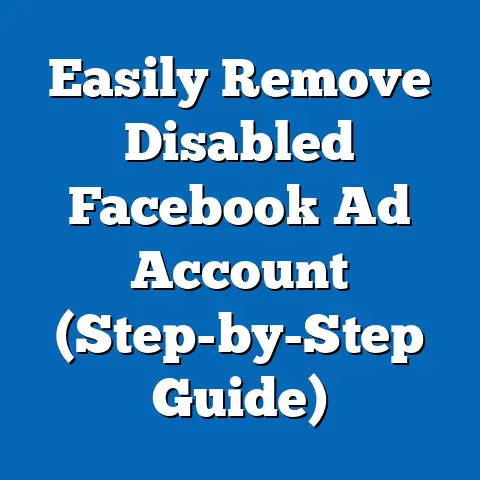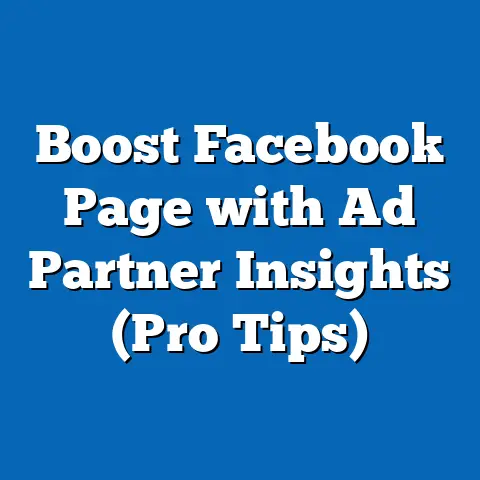Find the Best Facebook Ad Size (Ultimate Guide Unveiled)
Facebook advertising. It’s a landscape I’ve navigated for years, witnessing its evolution firsthand. From humble beginnings to the behemoth it is today, one thing has remained consistently crucial: getting the details right. And when it comes to Facebook ads, size really matters.
Think of your Facebook ads as tiny billboards vying for attention in a crowded digital space. A poorly sized ad is like a blurry, faded billboard – easily ignored. But an ad with the perfect dimensions? That’s the eye-catching masterpiece that stops scrollers in their tracks and drives real results.
The correct ad size can significantly impact your ad performance, engagement, and conversion rates. It’s not just about fitting the space; it’s about creating a seamless, visually appealing experience for your audience. If your images are cropped awkwardly or your video is stretched and distorted, you’re not just wasting ad spend, you’re potentially damaging your brand’s image.
Different types of ads serve different purposes and audiences, requiring specific sizes tailored to each format. A captivating Story ad, designed to grab attention in seconds, will have vastly different dimensions than a detailed carousel ad meant for product discovery. Understanding these nuances is the key to unlocking the full potential of your Facebook advertising campaigns.
In this ultimate guide, I’m going to pull back the curtain on Facebook ad sizes, sharing my years of experience and insights to help you create ads that not only look great but also deliver exceptional results. We’ll dive deep into the various ad formats, explore best practices, and even peek at the latest trends, all to equip you with the knowledge you need to conquer the Facebook advertising world. Let’s get started!
Section 1: Understanding Room-Specific Needs
Think of Facebook (and Instagram, since Meta owns both) as a sprawling mansion with many different rooms. Each “room” – News Feed, Stories, Marketplace, Instagram Feed, Instagram Stories – has its own unique atmosphere and user expectations. Your ads need to be tailored to fit each space perfectly.
Imagine trying to fit a grand piano into a tiny bathroom. It just wouldn’t work, would it? The same principle applies to Facebook ads. An ad designed for the News Feed might look completely out of place and ineffective in Stories.
Let’s break down some of these “rooms” and explore their unique needs:
- News Feed: This is the main hub of Facebook, where users scroll through updates from friends, family, and businesses they follow. Ads here need to be eye-catching and informative, blending seamlessly with organic content.
- Stories: These are short, vertical videos or images that disappear after 24 hours. Stories are all about immediacy and visual appeal. Ads here need to be quick, engaging, and mobile-first.
- Marketplace: This is Facebook’s platform for buying and selling goods. Ads here need to showcase products clearly and concisely, with a strong focus on price and availability.
- Instagram Feed: Similar to the Facebook News Feed, but with a stronger emphasis on visual aesthetics. Ads here need to be high-quality and visually appealing, fitting seamlessly with the curated content.
- Instagram Stories: Identical to Facebook Stories, these require vertical, engaging content designed for quick consumption.
Each placement has unique dimensions and specifications. For example, a square image ad (1:1 aspect ratio) might work well in the Facebook News Feed and Instagram Feed, but it would look awkward and take up too little space in Stories, which are optimized for vertical (9:16 aspect ratio) content.
These specific requirements cater to user experience. Meta wants to ensure that ads are relevant, engaging, and don’t disrupt the overall user experience. By adhering to the recommended dimensions and formats, you’re signaling to Meta that you’re committed to creating a positive experience for their users, which can ultimately improve your ad performance.
I’ve seen firsthand how an ad that works well in one placement can flop in another. I once ran a campaign promoting a new software product. The square image ads in the News Feed performed exceptionally well, driving a high click-through rate and conversions. However, when I repurposed the same ads for Stories, they were completely ignored. The small size and lack of vertical optimization meant they were easily lost in the sea of engaging Stories content. I quickly learned that adapting the creative to the specific “room” was essential.
Understanding the target audience and how their behavior in each placement can influence ad design and size is another crucial element. Are they passively scrolling through the News Feed, looking for interesting content? Or are they actively browsing the Marketplace, searching for a specific product? The answer to these questions will inform your ad design and size choices.
Key Takeaway: Think of Facebook ads as tailored experiences for different “rooms.” Understand the unique dimensions and user expectations of each placement to maximize your ad performance. Adapt your creative to fit the specific context and target audience for each platform.
Section 2: The Anatomy of Facebook Ad Sizes
Now that we’ve established the importance of understanding “room-specific needs,” let’s dive into the anatomy of Facebook ad sizes. Facebook offers a variety of ad formats, each with its own recommended dimensions and aspect ratios. Choosing the right format and size is crucial for ensuring your ads look their best and deliver the desired results.
Here’s a breakdown of the most common ad formats and their recommended specifications:
-
Single Image Ads:
- Description: A single image with accompanying text and a call-to-action button.
- Recommended Dimensions: 1080 x 1080 pixels (1:1 aspect ratio) for News Feed and Instagram Feed. 1080 x 1920 pixels (9:16 aspect ratio) for Stories.
- Why it’s important: Simple, versatile, and effective for driving awareness or promoting specific products.
- My experience: I’ve found that high-quality, visually appealing images work best for single image ads.
-
Carousel Ads:
- Description: A series of up to 10 images or videos that users can swipe through.
- Recommended Dimensions: 1080 x 1080 pixels (1:1 aspect ratio) for all placements.
- Why it’s important: Ideal for showcasing multiple products, telling a story, or highlighting different features of a single product.
- My experience: Carousel ads are great for e-commerce businesses looking to showcase their product catalog.
-
Video Ads:
- Description: Short video clips with accompanying text and a call-to-action button.
- Recommended Dimensions: 1080 x 1080 pixels (1:1 aspect ratio) or 1080 x 1920 pixels (9:16 aspect ratio) for vertical video.
- Why it’s important: Highly engaging and effective for capturing attention and conveying complex information.
- My experience: Video ads are especially effective when used in Stories, where the vertical format is optimized for mobile viewing.
-
Slideshow Ads:
- Description: A video-like ad created from a series of static images.
- Recommended Dimensions: 1280 x 720 pixels (16:9 aspect ratio) or 1080 x 1080 pixels (1:1 aspect ratio).
- Why it’s important: A cost-effective alternative to video ads, especially for businesses with limited video production resources.
- My experience: Slideshow ads can be a great way to repurpose existing image assets into engaging video-like content.
-
Collection Ads:
- Description: A mobile-only ad format that features a cover image or video followed by a selection of related products.
- Recommended Dimensions: Varies depending on the cover image or video. Product images should be at least 600 x 600 pixels.
- Why it’s important: Ideal for e-commerce businesses looking to showcase their product catalog and drive sales.
- My experience: Collection ads are particularly effective for mobile shoppers who are browsing for inspiration and discovery.
Single Image Ads:
- Description: A single image with accompanying text and a call-to-action button.
- Recommended Dimensions: 1080 x 1080 pixels (1:1 aspect ratio) for News Feed and Instagram Feed. 1080 x 1920 pixels (9:16 aspect ratio) for Stories.
- Why it’s important: Simple, versatile, and effective for driving awareness or promoting specific products.
- My experience: I’ve found that high-quality, visually appealing images work best for single image ads.
Carousel Ads:
- Description: A series of up to 10 images or videos that users can swipe through.
- Recommended Dimensions: 1080 x 1080 pixels (1:1 aspect ratio) for all placements.
- Why it’s important: Ideal for showcasing multiple products, telling a story, or highlighting different features of a single product.
- My experience: Carousel ads are great for e-commerce businesses looking to showcase their product catalog.
Video Ads:
- Description: Short video clips with accompanying text and a call-to-action button.
- Recommended Dimensions: 1080 x 1080 pixels (1:1 aspect ratio) or 1080 x 1920 pixels (9:16 aspect ratio) for vertical video.
- Why it’s important: Highly engaging and effective for capturing attention and conveying complex information.
- My experience: Video ads are especially effective when used in Stories, where the vertical format is optimized for mobile viewing.
Slideshow Ads:
- Description: A video-like ad created from a series of static images.
- Recommended Dimensions: 1280 x 720 pixels (16:9 aspect ratio) or 1080 x 1080 pixels (1:1 aspect ratio).
- Why it’s important: A cost-effective alternative to video ads, especially for businesses with limited video production resources.
- My experience: Slideshow ads can be a great way to repurpose existing image assets into engaging video-like content.
Collection Ads:
- Description: A mobile-only ad format that features a cover image or video followed by a selection of related products.
- Recommended Dimensions: Varies depending on the cover image or video. Product images should be at least 600 x 600 pixels.
- Why it’s important: Ideal for e-commerce businesses looking to showcase their product catalog and drive sales.
- My experience: Collection ads are particularly effective for mobile shoppers who are browsing for inspiration and discovery.
The implications of using the recommended sizes versus non-recommended sizes can be significant. Using non-recommended sizes can lead to cropping issues, blurred images, or distorted videos, all of which can negatively impact your ad performance. Facebook’s algorithm is also more likely to favor ads that adhere to the recommended specifications, potentially boosting your reach and engagement.
Each format can be utilized differently for branding, promotions, or lead generation campaigns. Single image ads are great for simple branding messages or promoting a specific product. Carousel ads are ideal for showcasing multiple products or telling a story. Video ads are highly engaging and effective for capturing attention and conveying complex information. Collection ads are perfect for driving sales for e-commerce businesses.
Key Takeaway: Choosing the right ad format and size is crucial for ensuring your ads look their best and deliver the desired results. Understand the recommended dimensions and aspect ratios for each format and tailor your creative accordingly. Don’t underestimate the importance of high-quality visuals and engaging content.
Section 3: Best Practices for Choosing Ad Sizes
Now that we’ve covered the anatomy of Facebook ad sizes, let’s move on to best practices for selecting the right sizes for your campaigns. Choosing the right ad size is not just about aesthetics; it’s about maximizing your ad performance and achieving your marketing goals.
Here are some actionable best practices to consider:
- Start with your objective: What are you trying to achieve with your Facebook ad campaign? Are you trying to drive awareness, generate leads, or sell products? Your objective will influence your choice of ad format and size.
- Consider your target audience: Who are you trying to reach with your ads? What are their interests, demographics, and online behavior? Understanding your target audience will help you choose the right placements and ad sizes.
- Prioritize mobile optimization: The majority of Facebook users access the platform on their mobile devices. Make sure your ads are optimized for mobile viewing, with clear visuals and concise messaging.
- Test different sizes and formats: Don’t be afraid to experiment with different ad sizes and formats to see what works best for your target audience and campaign objectives. A/B testing is your friend!
- Use high-resolution images and videos: Avoid using low-resolution images or videos that look blurry or pixelated. High-quality visuals are essential for capturing attention and creating a positive impression.
- Minimize text overlays: Facebook has strict guidelines regarding text overlays on images and videos. Keep your text overlays to a minimum to avoid getting your ads disapproved or penalized.
- Stay updated with Facebook’s guidelines: Facebook’s advertising guidelines are constantly evolving. Make sure you stay up-to-date with the latest changes to ensure compliance and optimal performance.
A/B testing different sizes to determine which performs best for specific audiences is a crucial step in the optimization process. I’ve seen campaigns where simply changing the ad size resulted in a significant increase in click-through rates and conversions. It’s all about finding the sweet spot that resonates with your target audience.
I remember a campaign I ran for a local restaurant. We initially used square image ads (1:1 aspect ratio) in the News Feed, but the results were underwhelming. We then decided to test vertical video ads (9:16 aspect ratio) in Stories, showcasing mouth-watering shots of their signature dishes. The vertical video ads performed significantly better, driving a much higher engagement rate and ultimately leading to more reservations.
Creating visually appealing ads that adhere to optimal size guidelines is also essential. Use high-resolution images, avoid clutter, and make sure your text is legible. Consider using graphic design tools like Canva or Adobe Spark to create professional-looking ads that stand out from the crowd.
There are also several tools and resources available for marketers to assist in creating ads that meet Facebook’s specifications. Facebook’s Ads Manager has built-in tools for resizing and cropping images and videos. There are also third-party tools like AdEspresso and Hootsuite Ads that offer features for creating and optimizing Facebook ads.
Key Takeaway: Selecting the right ad sizes for your campaigns requires a strategic approach. Start with your objective, consider your target audience, prioritize mobile optimization, test different sizes and formats, and use high-quality visuals. Stay updated with Facebook’s guidelines and leverage the available tools and resources to create effective Facebook ads.
Section 4: Recent Changes and Trends in Facebook Ad Sizes
The world of Facebook advertising is constantly evolving, with new features, formats, and guidelines being introduced regularly. Staying up-to-date with the latest changes and trends is crucial for ensuring your ads remain effective and compliant.
As of October 2023, there haven’t been any seismic shifts in recommended ad sizes, but Meta has been consistently refining its algorithm to prioritize user experience. This means that ads that are perceived as disruptive or irrelevant are more likely to be penalized.
One notable trend is the continued rise of video content. Video ads are becoming increasingly popular, especially on mobile devices. Meta is also investing heavily in augmented reality (AR) and virtual reality (VR) experiences, which could potentially lead to new ad formats and sizes in the future.
Mobile-first advertising continues to be a dominant force. With more users accessing Facebook and Instagram on their smartphones, it’s essential to prioritize mobile optimization in your ad campaigns. This means creating ads that are visually appealing and easy to consume on small screens. Vertical video, as mentioned earlier, is particularly well-suited for mobile viewing.
Another important trend is the increasing emphasis on personalization. Facebook is using its vast data trove to deliver more relevant and targeted ads to users. This means that advertisers need to focus on creating highly targeted campaigns that resonate with specific audiences.
It’s crucial to stay updated with Facebook’s advertising guidelines to ensure compliance and optimal performance. Facebook regularly updates its guidelines to reflect changes in its policies and algorithms. Violating these guidelines can lead to ad disapprovals, account suspensions, or even permanent bans.
I make it a habit to regularly check Facebook’s Business Help Center for updates on advertising guidelines and best practices. I also follow industry blogs and publications to stay informed about the latest trends and changes in the Facebook advertising landscape.
Key Takeaway: Stay informed about the latest changes and trends in Facebook advertising. Prioritize mobile optimization, embrace video content, focus on personalization, and stay updated with Facebook’s advertising guidelines. Continuous learning and adaptation are essential for success in the ever-evolving world of Facebook advertising.
Conclusion
Selecting the right Facebook ad size is more than just a technical detail; it’s a strategic decision that can significantly impact your ad performance and ROI. Understanding the nuances of each ad format, considering the unique needs of each placement, and staying up-to-date with the latest trends are all crucial for creating effective Facebook ad campaigns.
Throughout this guide, we’ve explored the various ad formats available on Facebook, discussed the recommended dimensions and aspect ratios for each format, and shared actionable best practices for selecting the right sizes for your campaigns. We’ve also highlighted the importance of understanding “room-specific needs” and tailoring your creative to fit the specific context and target audience for each platform.
By implementing the insights shared in this guide, you can enhance your Facebook advertising strategy and achieve better results. Remember, the key is to create ads that are visually appealing, engaging, and relevant to your target audience. Don’t be afraid to experiment with different sizes and formats to see what works best for your business.
Ultimately, understanding room-specific needs can lead to better ad performance and ultimately higher returns on investment. So, go forth and create amazing Facebook ads that capture attention, drive engagement, and deliver the results you’re looking for!
Now, go and experiment! I’m confident that with the knowledge you’ve gained here, you’re well on your way to mastering the art of Facebook ad sizing and crafting campaigns that truly shine. Good luck, and happy advertising!

